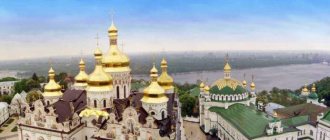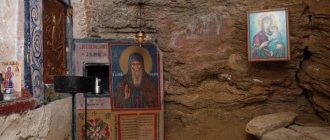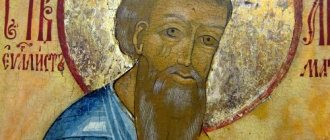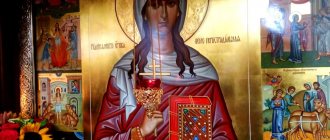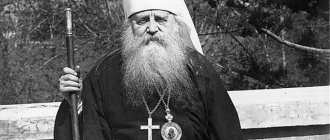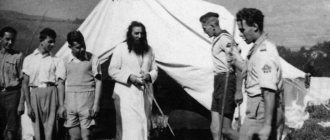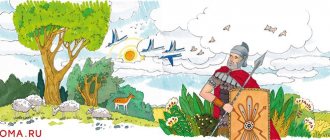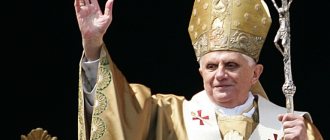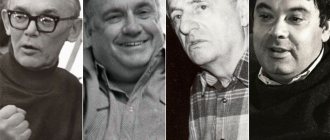| Rev. Anthony the Roman, icon |
Anthony the Roman
(1067 - 1147), abbot, founder and first abbot of the Novgorod Anthony Monastery, wonderworker, reverend Memory January 17 (name day), on the first Friday after the celebration of the supreme apostles Peter and Paul (June 29) (in honor of the discovery of relics), 3 August and in the Cathedral of Novgorod Saints
Born in 1067 in Rome from wealthy parents who adhered to the Orthodox confession of faith, and was raised by them in piety. Deprived of his parents at the age of 17, he began to study the writings of his fathers in Greek. Then he distributed part of the inheritance to the poor, and put the other in a wooden barrel and put it into the sea. He himself took monastic vows in one of the desert monasteries, where he lived for 20 years.
Persecution of the Orthodox by the Latins forced the brethren to disperse. The Monk Anthony wandered, moving from place to place, until he found a large stone on the deserted seashore, on which he lived for a whole year in fasting and prayer. A terrible storm that broke out on September 5, 1105, tore off the stone on which the Monk Anthony was located, and carried it into the sea, and the saint floated on the stone, “as if he were lighter on ships.” On the feast of the Nativity of the Blessed Virgin Mary, the stone stopped 3 versts from Novgorod on the banks of the Volkhov River near the village of Volkhovskoye. This event is attested in the Novgorod chronicles. At this place the monk founded a monastery in honor of the Nativity of the Most Holy Theotokos. The next year, fishermen caught a barrel containing the inheritance of the Monk Anthony, which had been put into the sea many years ago. Having indicated what was in the barrel, the monk took the barrel and bought land for the monastery.
The spiritual charter and the First Chronicle of Novgorod also report that the saint (the chronicle does not call him a “Roman”) received a blessing for the construction of the monastery from the Bishop of Novgorod. Nikita, i.e. no later than the beginning of 1109, that the monastery church was founded by the saint in 1117, consecrated in 1119, painted in 1125; in 1127 St. Anthony began to build a “triple stone stone” in the monastery.
The installation of the monk as hegumen took place only in the first year of the bishopric of Nifont, in the winter of 1131/1132, which suggests some kind of conflict between the venerable one. Anthony and Novgorod bishop. John (Popyan) (1110-1130).
Spiritual asceticism was combined in the monastery with intense work activity. The Monk Anthony made sure that the monastery's income provided assistance to the poor, orphans and widows.
The monk died on August 3, 1147, being 79 years old, and was buried in the Nativity Cathedral of the monastery he founded, near the western wall.
The limited information about the monk is contained in the First Chronicle of Novgorod and is supplemented by data from his life (“The Legend of the Life of our Venerable and God-Bearing Father Anthony the Roman and the Coming from the City of Rome to Veliky Novgorod”), known in lists starting from the second half of the 16th century. It is possible that the life is based on an earlier unpreserved hagiographic text (prologue life), possibly written by Andrei, the second abbot of the Anthony Monastery (1147 - 1157), who in the surviving life is named as its author. Together with the life of St. Anthony in handwritten collections usually contains a preface, “A word of praise on the most honorable memory of our reverend and God-bearing father Anthony the Roman” (written c. 1591, list: State Historical Museum. Music. No. 1236, end of the 16th century) and a legend about miracles and the acquisition of relics (“On the Translation of an Honest and Many-Wonderful Body” (March 1598), list: State Historical Museum. Vostr. No. 1053, early 17th century), written by Nifont, a tonsure of the Anthony Monastery, who worked in the 1580-90s, to whom sometimes he is also credited with compiling a life. In at least two copies of the 16th-17th centuries, the spiritual letter of Anthony the Roman is known (doubts about its authenticity do not have sufficient grounds; the most likely dating of the letter is before 1131/32). In the same manuscripts where the spiritual charter is found, the deed of sale of Anthony the Roman for the land for the monastery near the river is preserved. Volkhov; in the description of the boundaries of the site, the deed of sale [1], in all likelihood, is a falsification of the second half of the 16th century, but in its basis (the form, the fact of the purchase of land by the monk) goes back to the original of the 12th century.
Reverence
Veneration of St. Anthony in the monastery and in nearby villages can be traced no earlier than the 16th century. With abbot. Benjamin (1547-1552) the stone of Anthony the Roman, which until then had been on the banks of the Volkhov, was transferred to the monastery, the image of the saint was painted on the stone and mounted in the wall of the cathedral, but subsequently, as stated in the story “On the Translation of the Honest and Many-Wonderful Body,” the stone lay neglected against the wall of the cathedral.
In 1580, by order of Tsar Ivan the Terrible, a new abbot arrived at the monastery. Kirill (Zavidov). The abbot was sick because he was poisoned. Walking around the monastery, he found a stone with a half-erased image of the saint and was healed near it through the prayers of the monk. By order of the abbot. Kirill over the stone at the west. a small chapel was placed on the walls of the cathedral and the image of Anthony the Roman was restored. The brethren, led by the abbot, came every day and venerated the image; the possessed Fedor the candle-maker was healed at the stone. "Anthony's Canes" - stems of seaweed, brought, according to legend, along with a stone, cured toothache.
Because according to prayers to St. A large number of healings occurred to Anthony the Roman, mon. Nifont began to petition for the discovery of the relics of the saint, which took place on August 3, 1597; in the same year, the saint was canonized for all-Russian veneration; at the same time, a service to the saint was probably compiled (the oldest lists are from the late 16th-17th centuries), it speaks of the relics of the saint. Anthony, Novgorod and the Anthony Monastery are often mentioned. Healings at the stone and relics of the saint continued in the monastery; by the end of the 17th century, 18 new miracles were recorded [2].
The relics of St. Anthony was placed in a silver-bound shrine. From that time on, a religious procession was established in his memory from the St. Sophia Cathedral, on the first Friday after Peter's Day. At the saint's shrine there was a branch of sedge, with which Anthony sailed from Rome, holding it in his hand. This is how he is depicted on icons.
Until 1927, the relics of St. Anthony rested in the cathedral monastery Church of the Nativity of the Blessed Virgin Mary, in the chapel named after him. During the anti-religious campaign, the cancer was opened, and the relics were sent to the museum, which was located in the St. Sophia Cathedral of the Novgorod Kremlin. There the relics of Anthony the Roman were lost among others and were considered lost.
Work on a comprehensive study of the relics stored in the St. Sophia Cathedral began around 1996.
A Moscow scientist, candidate of biological sciences Denis Pezhemsky, worked with the remains, which could be the relics of St. Anthony. In 2016, he reported: “It was possible to isolate the relics of Anthony the Roman from the complex of remains.
The historical and anthropological research has been completed. The relics of Anthony the Roman were handed over to Metropolitan Leo of Novgorod and Staraya Russia” [3].
Particles of the relics were found in the local history museum of Petrozavodsk in 2000 and transferred to the city cathedral in the name of the holy noble prince Alexander Nevsky.
The Stone of Anthony the Roman has been preserved and is located in the western aisle of the Nativity Cathedral. This is a gray oval boulder 126 cm long, 94 cm wide and 37 cm high.
Troparion
You left Old Rome, your fatherland, / on a stone, like on a light ship, / and on it, more than nature, as if incorporeal, you walked along the waters, / guided by the providence of the Divine mind, / you reached Great Novagrad / and, the monastery in having created it, / you offered your body in it, as if it were a sanctified gift. / Thus we pray to you, Father Anthony: / pray to Christ God to save our souls.
Literature
- NPL (as specified); GVNiP. No. 102, 103;
- GANO. F. R-138. Op. 3. Unit 24. L. 1-34.
- Life of St. Anthony the Roman // PS. 1858. No. 5. P. 151-171; No. 6. pp. 310-324.
- Klyuchevsky. Old Russian Lives. pp. 306-311;
- Barsukov. Sources of hagiography. Stb. 48-51;
- Sergius (Spassky). Monthsword. T. 2. P. 17, 235;
- Valk S.N. Initial history of the Old Russian private act // Auxiliary sources. disciplines: Sat. Art. M.; L., 1937. P. 295-303;
- Spassky F. G. Russian liturgical creativity. P., 1951. S. 208-210;
- Onasch K. Zur Vita Antonij “des Römers” // Orbis scriptus: D. Tschižewskij zum 70. Geburtstag. Münch., 1966. S. 581-585;
- Yanin V.L. Essays on integrated source study: Medieval Novgorod. M., 1977. S. 40-59;
- aka. Seal of Novgorod Bishop Ivan Popyan // VID. 1978. Vol. 9. pp. 47-56;
- aka. Novgorod Acts of the XII-XV centuries: Chronol. comment M., 1991. S. 205-207, 354-357;
- Makarov N. A. Stone of Anthony the Roman // NIS. L., 1984. No. 2 (12). pp. 203-207;
- Andreev V. F. Novgorod private act of the XII-XV centuries. L., 1986. P. 93-97;
- Fet E. A. Life of Anthony the Roman // SKKDR. Vol. 2. Part 1. pp. 245-247.
- Macarius (Mirolyubov), archimandrite. Archaeological description of church antiquities in Novgorod and its environs. M., 1860. Part 2. P. 51, 82-83, 120, 308-310;
- Laskovsky V.P. Guide to Novgorod. Novgorod, 1910. P. 222;
- Dimitri (Sperovsky), bishop. Ryazansky. About the internal structure and decoration of the churches of the Novgorod Anthony Monastery in the 17th century. compared to their current state // Tr. XV Archaeol. congress in Novgorod. M., 1911. T. 1; Antonova, Mneva. Catalog. T. 2. P. 28, 200-201;
- Russian wooden sculpture. M., 1994. S. 222-224, 227. Cat. 163, 164;
- Kostsova A. S., Pobedinskaya A. G. Russian icons of the 16th - early 20th centuries depicting monasteries and their founders: Cat. vyst. / GE. St. Petersburg, 1996. pp. 57-60, 133-138. Cat. 50-56;
- Russian monasteries: Art and traditions / State Russian Museum. B. m., 1997. P. 142-143;
- Markelov. Saints of Ancient Rus'. T. 2. P. 56;
- Koltsova T. M. Northern icon painters: Experience of biobibliogr. dictionary Arkhangelsk, 1998. P. 81;
- Milchik M.I., Secretary L.A. Novgorod St. Anthony's Monastery on icons of the 16th-18th centuries. // PKNO, 1999. M., 2000. P. 273-299.
Arrival of the Venerable One in Russia
The Monk Anthony the Roman was born in Rome in 1067 into a family of wealthy citizens. His parents were Christians, therefore they raised their son in meekness and piety. Having entered his adolescence, Anthony became seriously interested in studying the theological works of the Eastern Church and patristic literature. When he was 17 years old, he lost his father and mother. It was this event that prompted the young man to change his life radically, and he made a firm decision to leave the Roman capital and then become a monk. There was another reason: at that time the Popes made every effort to convert the people to Latinism. Anthony did not see his own existence without Eastern Orthodoxy, his soul becoming attached to it.
The future saint did not think through his path to the smallest detail. He did not rely on himself, but completely surrendered his essence, life and destiny into the hands of the Creator. The young man distributed one part of the inheritance that he inherited from his loving parents to the poor and disadvantaged, put the other in a barrel and threw the last into the sea, and without a single penny of money he himself went on long journeys to the monasteries where monks lived and existed in accordance with the Orthodox faith. Christians. Anthony lived in one of the monasteries for 20 years, accepting the monastic feat. The persecution of the Orthodox by the Latins put an end to this: in connection with these events, the saint, and all the brethren of the monastery, had to wander. This went on for quite a long time until Anthony managed to find a huge boulder on the deserted sea coast. Here the saint stopped and spent a whole year on the stone, fasting and incessantly praying.
On September 5, 1105, a monstrous storm broke out in those places. As a result, the stone on which the ascetic stood was thrown by the wind into the depths of the sea. It was carried along the waves, then the boulder, together with the monk, ended up at the mouth of some river, and finally, on the eve of the Nativity of the Blessed Virgin Mary, it washed up on the bank of the Volkhov River, which flowed near the village of Volkhovskoye, three miles from Novgorod.
Used materials
- A. V. Nazarenko, L. A. Secretary. “Antony the Roman” // Orthodox Encyclopedia, vol. 2, p. 675-677
- “Reverend Anthony the Roman” // Orthodoxy.Ru
[1] Latest publications: Certificates of Veliky Novgorod and Pskov.M. -L., 1949, p. 159-161, N 102, 103; Yanin V. L. Essays on integrated source study. Medieval Novgorod. M., 1977, p. 58-59
[2] State Historical Museum. Khlud. No. 199, late 17th century
[3] “Thousand-year-old relics of St. Anthony the Roman found in Veliky Novgorod,” February 28, 2016 —
Venerable Anthony the Roman of Novgorod - an Italian with a Russian soul
There are names of saints in the Orthodox calendar who clearly and directly speak with their entire lives that the homeland of a Christian is where Christ is. The adventures of an Italian in Russia - this is how, in a secular sense, one can title the biography of St. Anthony the Roman of Novgorod. And although there were no cinematic adventures in his life, there were other events in it that surpassed human nature - feat, sincere faith and piety.
The future saint was born in 1067 - the same year when the capital of our country, Minsk, was first mentioned in the chronicles. Anthony's family was very wealthy, the child grew up without needing anything. But the boy did not show any interest in earthly goods - from an early age he was most drawn to Orthodoxy.
In 1054, a schism occurred that divided the Christian world into Orthodox and Catholic. Most Roman citizens followed the Catholic path, but Anthony's father and mother raised their son in the orthodox - Orthodox - tradition. And they did this so sincerely and faithfully that when they died, leaving the seventeen-year-old boy an orphan, he chose for himself the path of Orthodox monasticism.
Anthony distributed most of the wealth he inherited to the poor. He kept only a few family treasures for himself, but he did something very unusual with them: he put everything in a wooden barrel, tarred it and threw it into the sea. It is unlikely that he hoped to get his wealth back or intended to test the power of his prayer in this way... Anthony did not intend to go on a sea voyage, his goal was to renounce the world. Following the dictates of his heart, he chose a secluded monastery for himself and spent 20 years there in silence, work and prayer.
However, at that time the world was far from calm. Danger could be expected from their own fellow tribesmen. And all because at the beginning of the 12th century the confrontation between the Latins and the faithful of the Orthodox Church was gaining momentum. Who would have thought that clashes between believers, who until recently called themselves one word - Christians, could become so fierce. Cathedras were seized, churches were destroyed, and there was a struggle for power and influence. Sometimes blood was even shed. And the Orthodox monastery, where the monk Anthony labored, at a certain moment was occupied by Catholics.
The monks scattered in all directions. Saint Anthony was also forced to seek refuge for himself. Without abandoning the silence and solitude he loved, he lived for a whole year in a cave on a deserted shore. And perhaps it would have remained there if, by the will of the Almighty, a severe storm had not occurred on September 5, 1105. The crushing blow of the sea wave fell exactly on the part of the coast where the monk was hiding. A stone broke off from the rock and, contrary to all the laws of nature, floated upstream with the saint. For several days the fragment drifted across the waters until it, like a small boat, landed on the shore. The Novgorod land, or rather the village of Volkhovskoe, appeared before the gaze of the astonished monk. The distance to Veliky Novgorod was only three kilometers, and to Rome - almost three thousand.
Saint Anthony did not immediately understand where the sea had brought him. Fortunately, he met an artisan who knew many languages, including Latin. The monk realized what land he was in, and immediately turned to God with sincere prayer... No, not to beg Him to return home. He asked the Lord to begin to understand the language that the local people spoke. Church tradition says that this happened immediately. Although there is an opinion that the saint gradually mastered Russian speech, thanks to local residents who reached out to him in a string, feeling a pure soul in their hearts and seeing an ascetic lifestyle. Information about miraculous events has reached us, among other things, as part of the Novgorod chronicles. The saint told the secret of his arrival in Rus' only to Saint Nikita.
The next year, another incredible event happened in Volkhov: fishermen caught a barrel - tarred and sealed, full of jewelry. The Monk Anthony recognized in it his hiding place, which he had once sent across the waves. He accurately described the contents of the barrel and received his property, which he immediately used to build a new monastery.
The memorable day on which the saint was thrown ashore by the waves was the eve of the Feast of the Nativity of the Virgin Mary. And now the monastery, built precisely in the very place where the ascetic first set foot on Novgorod land, was consecrated in honor of the Nativity of the Blessed Virgin Mary. The cathedral of the same name was erected in the monastery in 1117. The white stone temple was painstakingly decorated with paintings over the course of eight years. In 1131, Saint Anthony was awarded the priesthood, and soon the former Italian monk became abbot of the Russian monastery.
For sixteen years the ruler of the monastery ruled, being a true spiritual father for all the brethren. Deeds of mercy, piety and a life pleasing to God - this is what he tirelessly repeated to the monks and he himself showed the clearest example of this. Even during his lifetime he was considered an ascetic. And most of all they were respected for their sincere humility and righteous life, which served as an example for all monks.
At the Novgorod See, the Lord brought together two saints of the Russian Orthodox Church - St. Anthony the Roman and St. Niphon of Pechersk. The latter, being the bishop of the Novgorod land, himself ordained the Italian monk as a presbyter. He, with the concelebration of a council of priests, performed the funeral service for the abbot in his own monastery. The monk peacefully surrendered his soul to God on August 3, 1147.
After the death of the saint, healings began to take place at his tomb. Through the prayers of Anthony, Bishop Kirill, who was abbot of the monastery from 1580 to 1594, was healed of a fatal illness. In gratitude, he built a chapel over the preserved stone of the ascetic - the same one that brought the Italian across the waters to Holy Rus'. An image of the saint was later painted on this piece of rock.
Both monks and pilgrims came to the burial place of the first abbot with petitions. The monk appeared in a vision to a certain man named Fedor, possessed by a demon. At the command of the saint, Fyodor kissed the stone and instantly received healing from the evil spirits that tormented him.
The fact that the time had come to glorify the Monk Anthony was revealed to one of the inhabitants of the monastery named Niphon, a man of righteous life. Together with the former abbot Kirill (who at that time was the archimandrite of the Trinity-Sergius Monastery), Nifont petitioned His Holiness Patriarch Job for the discovery of the relics of the monk, their transfer to a new shrine and display in the church for veneration. The Primate of the Russian Orthodox Church blessed the charitable deed. In preparation for this reverent event, all the brothers of the monastery, led by Metropolitan Varlaam of Novgorod, observed strict fasting for some time, reading special prayers addressed to the saint. At the end of the fast, the Monk Anthony appeared to Metropolitan Varlaam and gave his blessing to carry out the Patriarch’s order. Only after this, on July 1, 1597, was the coffin with the holy relics opened.
As the chronicle testifies, after opening the tomb, the holy relics of the saint were discovered “as if lying alive.” An unearthly fragrance from them spread throughout the monastery. A new shrine with relics was installed next to the place of the previous burial, where the sick immediately began to be miraculously healed. In the same year, the Monk Anthony was glorified among the saints.
Despite the fact that almost a thousand years of time separate us from the saint, we can draw a parallel with modernity and put ourselves in the place of the saint. In our tolerant country, we have to make a choice every day. This applies to religion and more. Could we live in a rich family, but think about God? Having become orphaned, should you not go down the downward path, squandering a huge fortune, but give up all your money and devote yourself to God? More than once to lose what we love with all our hearts (family, friends, privacy), and not lose heart? Find yourself on a rock, even in an uncontrollable boat, and rush in an unknown direction, risking drowning in the abyss? Find yourself in a foreign land and become one of the local people? Love them with all your heart?
There were many miracles from God in the life of Saint Anthony. However, throughout the entire earthly time allotted to him, he burned with a great desire to fulfill God’s will for himself, whatever it may be. And this choice - sincere humility and calm acceptance of everything that the Lord sends - St. Anthony the Roman made throughout his life. May God help us, through the prayers of the saint, to make the same choice.
16.08.2018
Prayers
Our good shepherd and mentor, Rev. Father Anthony! You are still in the flesh, controlled by the Divine beckoning, you left the old Rome of your fatherland and your family, and from there you sanctified this city with miraculous waters on stones, like light ships, by your coming, and in it you erected the temple of the Mother of God, With your labors and exploits you enlightened your abode, even the foundation of your existence, you multiplied your children in it, instructing them in the image of good deeds and teaching; With this and the incorruptibility of your relics and miracles, God glorified you with radiance, He who is incorporeal and incorporeal before you rejoices, and rejoicing in those who flow to your miraculous race, and pray to your relics with your lips and kissing your heart: you even now, as if you have boldness towards the Lord Christ , be a prayer book and intercessor for these upcoming servants of yours, who bow to your honest image and ask for your merciful intercession. We pray to you, servant of Christ and saint, our heads and hearts bow to you; do not despise this poor prayer of ours, but look upon us mercifully, fulfilling our every need: health to those who are sick, prosperity to those traveling along the way, granting speedy and comfortable voyage to those sailing: save us from all troubles that suddenly find us; May we all live a godly life on earth through your prayers, and we will be heirs of the heavenly kingdom, worthy of glorifying the All-Holy Trinity, the Father, the Son, and the Holy Spirit, forever and ever. Amen.
